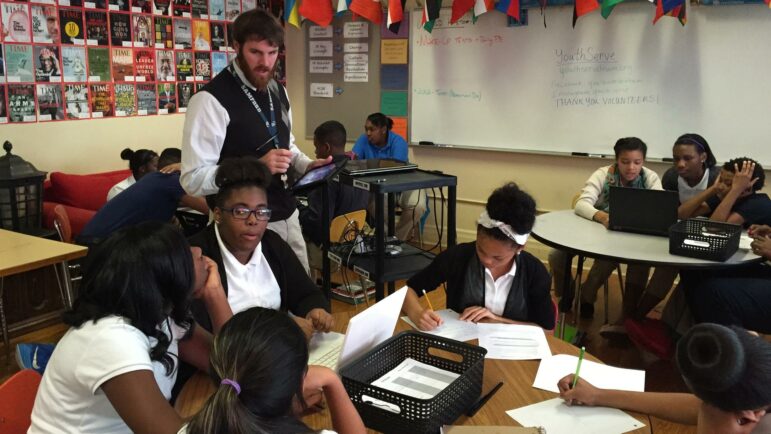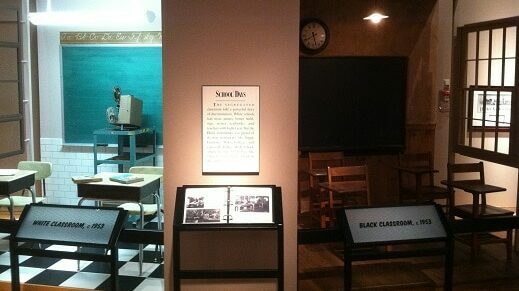Black School, White School: Teaching The Civil Rights Movement
One of many Birmingham Civil Rights Institute exhibits that show the separation of black life and white life. Differences in the teaching of that history remain.
Most people know Birmingham was a Civil Rights Movement battleground. But how is that complicated history taught in schools today? And are there differences between white and black districts? As part of our special Civil Rights anniversary coverage, Southern Education Desk reporter Dan Carsen went to class in urban Birmingham and suburban Mountain Brook to find out. Read below, or listen above.
According to the Southern Poverty Law Center, Alabama schools teach the Civil Rights Movement better than those of any other state. But zoom in to the district level and it’s all over the map. Birmingham City Schools are 95% Black, but in nearby Mountain Brook, the student body is 98% white. You might expect differences in how Civil Rights history is taught, and according to social studies teacher JohnMark Edwards, you’d be right.
“It’s certainly different teaching white kids about the Civil Rights Movement,” he said. “You might have a poster, you might have an activity, but it’s not the theme like it is in a black school. It’s two different heritages.”

Edwards attended relatively wealthy white school systems and student-taught in several, including Mountain Brook. His masters thesis was on resistance to school desegregation in and around Birmingham.
Now he teaches in the building Fred Shuttlesworth almost died trying to integrate — Phillips Academy, a 98% Black K-8 magnet school. He imparts the lessons of the Movement through lectures, art, role-playing, and field trips. But even at a black school with high-achieving students, distance in time breeds unfamiliarity.
“I’m always shocked by the things I’m able to teach them as brand new, fresh, never heard this before,” he said.

Sam Pugh of the Birmingham Civil Rights Institute is trying to remedy that. I catch up with him after he captivates a gym full of students with a group tug-of-war between “freedom” and “the establishment.” He offers a partial explanation for the spottiness of Civil Rights education:
“Because the history is harsh, I think a lot of people try to avoid it,” he says, adding that it’s easier to avoid in communities where the majority of people weren’t on the receiving end of the persecution. He goes on, “I think there’s something about America where we don’t want to hear about the bad side of America.”
But Mountain Brook High School history teacher Joe Webb plows right in. He hits key facts and makes no
bones about sharing personal impressions, including his thoughts on Rosa Parks.
“What I don’t get,” he tells his class, “… somebody asked a lady to get up … My dad today would come out of his grave and get me. If she’s a Martian, it doesn’t matter — get your little self up!”

On the landmark Brown versus Board of Education school desegregation case, he explains, “This says ‘separate is not equal.’ Why is it that people would change their mind that drastically? Generations at times change. My grandmother was awful about this. She was racist as all-get-out. My mother was better than that, I’m better than that, and my kids are awesome: a Ukrainian and two Mexican guys — that’s his peeps, that’s who he hangs with.”
Despite differences in approach, whether students are in Birmingham or Mountain Brook, they seem to grasp the significance of that societal change. Mountain Brook junior Laura Screvens says,”It’s definitely important to learn about because it’s great to know about your history and where you come from, and not to repeat it, and how to treat people like they need to be treated.”
Birmingham Phillips Academy seventh-grader DeVaun Jemison also makes the connection from history to herself.
“They were sacrificing their lives and risking their lives just to … basically get what they deserved, which is freedom and fairness, in order for us to have a better life.”
Almost every adult and student I spoke with says knowing Civil Rights history makes us less likely to return to society-wide persecution, of any group. It seems that learning this key part of America’s past has ramifications beyond report cards.

Alabama Power seeks to delay rate hike for new gas plant amid outcry
The state’s largest utility has proposed delaying the rate increase from its purchase of a $622 million natural gas plant until 2028.
Former U.S. Sen. Doug Jones announces run for Alabama governor
Jones announced his campaign Monday afternoon, hours after filing campaign paperwork with the Secretary of State's Office. His gubernatorial bid could set up a rematch with U.S. Sen. Tommy Tuberville, the Republican who defeated Jones in 2020 and is now running for governor.
Scorching Saturdays: The rising heat threat inside football stadiums
Excessive heat and more frequent medical incidents in Southern college football stadiums could be a warning sign for universities across the country.
The Gulf States Newsroom is hiring an Audio Editor
The Gulf States Newsroom is hiring an Audio Editor to join our award-winning team covering important regional stories across Mississippi, Alabama and Louisiana.
Judge orders new Alabama Senate map after ruling found racial gerrymandering
U.S. District Judge Anna Manasco, appointed by President Donald Trump during his first term, issued the ruling Monday putting a new court-selected map in place for the 2026 and 2030 elections.
Construction on Meta’s largest data center brings 600% crash spike, chaos to rural Louisiana
An investigation from the Gulf States Newsroom found that trucks contracted to work at the Meta facility are causing delays and dangerous roads in Holly Ridge.









